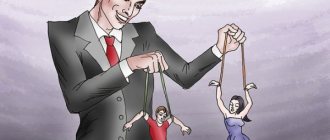Victimization is a concept that in some psychological modalities is interpreted as the process of becoming a victim. According to one of the founders of the doctrine of positivist victimology, B. Mendelssohn, the concept of “victim” is the opposite of the concept of “criminal”.
The very term “victim” and the theory that a person, unconsciously or consciously, by his behavior provokes a criminal to commit violent acts, causes a lot of controversy among psychologists.
What is victimization behavior
The concept of “victim behavior” is often used in criminal psychology. Specialists in this area consider the victim’s behavior from two points of view.
According to the first, a person who has suffered from violent acts provokes the rapist to commit a crime - attacks, threatens, beats, robs or commits other dangerous actions. According to the second version, the victim does not consciously provoke, but certain actions on her part make the rapist want to demonstrate aggression
.
As an illustration, we can consider the actions of a doctor who was unable to help a patient (due to an error or other reasons); this caused the patient or his relatives to want to take revenge on the specialist. If we consider this situation from the first point of view, then the patient plays the role of the victim. He chose a specialist who played the role of the rapist. The patient-victim at the treatment stage sees in the doctor a strong person who can be trusted and admires him. The victim herself, who finds herself in a similar situation, is characterized by low self-esteem, shy and timid. Often such a person shifts the blame for his mistakes and failures onto those around him, “fate”.
Adhering to the second interpretation, we consider the situation as follows. The specialist takes the position of a rapist - he conflicts, uses physical or other types of violence. When he meets a stronger opponent in the person of a relative of the patient, he himself enters into the role of the victim.
It also happens that a physically and psychologically very strong person chooses to play the role of a victim. He is forced to make such a choice by circumstances in which it is necessary to protect himself or loved ones from injustice, to defend his own principles. Such behavior is not considered pathological and is justified in a psychological sense.
Karpman triangle
Do you know the situations in which a husband drinks himself into unconsciousness and beats his wife, and she periodically calls the police, asks neighbors for help, but eventually returns to him again and the massacres begin again?
In their relationship, the tension becomes unbearable and there is a need to “release” it. The victim may unconsciously give a signal to the aggressor. He makes an attack. Someone acts as a rescuer. Unfortunately, it often happens that it is children who perform this function.
And then, when the tyrant is stopped, a role reversal occurs. The victim turns into an attacker, somehow punishing him for what happened. And over time, everything returns to its place, until anxiety in the relationship goes off scale again.
This phenomenon even has a name “Karpman triangle”. It’s kind of a vicious circle, because in the system the role of each participant is not assigned. They change places. Then the rescuer attacks the victim, quite reasonably presenting claims to her that he helped in vain. Since she remains with the tyrant, who, in turn, can begin to protect her.
In general, this is a complex process that is quite difficult to understand and change without the involvement of a specialist.
And what’s most interesting is that the tyrant and the victim always find each other. Even if something doesn’t work out for one couple, they will find “other halves”, so to speak, based on their interests.
Therefore, it is important not just to leave the relationship, but also to work on your awareness. Only by understanding what I do and present to the world, that I attract a certain category of individuals into my life, will I be able to change this.
In the meantime, I will shift all the blame onto those who were next to me or on circumstances - I will fall into the same trap.
Basic principles of victimization
The tendency to victimize is formed in childhood and consolidated in adolescence. One of the most important factors in the formation of victimization in children is the situation of physical and emotional violence in the family. A significant role is also played by the destructive influence on the psyche of adolescents from significant adults (relatives, teachers), and peers.
Under the influence of these factors, certain personal characteristics appear:
- increased anxiety, uncertainty and low self-esteem;
- emotional instability;
- the tendency to ignore one's own interests in favor of others.
Often, a “victim” with low self-esteem strives to prove his strength, rightness, and test his strength. This results in risky behavior (most often in adolescents).
In some cases, victimization is a concomitant of mental disorders. Problems of social adaptation of a pathological nature can result in a tendency to masochism and sadism, exhibitionism, and nymphomania. Similar manifestations of mental abnormalities can occur among victims of crimes (sometimes repeated with the same victim).
A person can also fall into the position of a victim if he:
- is in a subordinate position, he fulfills the demands of the aggressor, but very slowly, which “angers” the attacker even more;
- behaves provocatively or in his usual way, but the abuser views his behavior as offensive.
The fact that the aggressor in both these cases perceives the actions of the “victim” as offensive and unacceptable is solely his subjective opinion of the attacker. It is connected with the peculiarities of his perception and thinking.
Reasons for appearance
Hypochondria, lack of attention
I probably won’t surprise you, but victim behavior originates from childhood. Namely, when parents or other adults who “raise” a child pay attention to him only when he feels bad. That is, they “turn on” emotionally and begin to show concern.
He masters this mechanism well and subsequently unconsciously transmits it to others. When everything is good and calm, he is no longer particularly happy with it, because he feels a lack of interest in himself, warmth, sympathy, and so on.
Trespassing
Or, if the child had to endure something, endure it, being afraid to say what he doesn’t like. For example, so as not to be rejected. Yes, even parents. Or they weren’t punished if they refused to eat something. There are many ways that violate another person's boundaries.
We, sometimes without noticing, harm loved ones, committing violence as if with the best intentions.
For example, if you force a child to eat what is put on the plate. Even if you don’t like the food, ignoring the body’s own signals that it is no longer suitable and disgust has already appeared. And this needs to be done, because my mother tried, she prepared. And my grandmother actually survived the war, saw hunger and death from it.
This is already violence. Because over time, he will forget how to listen to his desires and feelings, which means he will live as he is told.
It is very important to teach children to stand up for themselves, to say “no” if they don’t want to do something, to respect and value themselves.
Reducing Anxiety
Instability and the unknown cause anxiety and fear. Therefore, some people have to use control to get rid of this intolerable condition. Then everything is predictable, understandable and known.
In childhood, such people did not just play dirty tricks to get attention, some used this way to control their parents and their reactions. That is, it was easier for them to receive punishment and calm down than to constantly be in anxiety. After all, what if this happens at a moment when they don’t expect it?
This is when the “victim complex” begins to form.
How does victimization manifest itself?
Victim behavior , according to some experts, is reflected in the fact that a person often finds himself in situations where he finds himself in the position of the victim. In criminal psychology, victimization is considered as the ability to “attract” and attract the attention of antisocial individuals - rapists, maniacs.
According to victimization theory, the victim behaves in a certain way. His behavior arouses increased interest and awakens the desire to show aggression in the criminal.
Victim behavior from a psychological point of view
According to supporters of the victimization theory, it is especially often demonstrated by adolescents who:
- very ambitious;
- tend to defend their point of view;
- maximalistic;
- have insufficient life experience.
All of these factors cause teenagers to often find themselves in unpleasant, and often dangerous, situations. It’s not the result they hoped to get that forces them to “go for a second round” and achieve their goal. This again turns into trouble.
Some people tend to conflict even when there are no objective reasons for a clash. But it is known that those who offend their peers direct aggression towards children and demonstrate special behavior. They do not enter into conflicts even if their personal interests are affected; they try to avoid confrontation and hide from troubles.
“Victims” are vulnerable, naive, and physically weaker than their offenders. The appearance of those who more often than others fall into the “victim” position also attracts attention. Teenagers often have an absent-minded look, a rustic expression on their faces, stoop, their gait is uncertain, mincing.
Here we cannot help but emphasize that legal experts and the vast majority of psychologists believe that such “signs of a victim” in no way justify the criminal and do not reduce the degree of his guilt for the violence committed.
Two types of victimization behavior
People who tend to exhibit victimized behavior can take the place not only of a potential victim, but also of a rapist. Therefore, there are 2 very different types of behavior.
Compromising or conforming - people take on the role of a victim, expect violent actions against them, deception, and insults. They show timidity, easily submit to the will of others, and often not only justify the behavior of their rapist, but also consider it correct. The reason for such “worship” of the aggressor is that the victim sees in him a stronger personality who is capable of committing actions that she herself does not dare to do.
People with a conformist position have low self-esteem; they are confident in their insignificance and inability to decide or be responsible for anything. They shift the blame for their failures onto external circumstances or other people, like to complain, and do not hide their position: “What about me? I'm just a victim."
Demonstrative or emotionally unstable behavior is typical for people who themselves show aggression and provoke others. The form of provocation can be open or implicit. This behavior manifests itself in bullying of the weaker and psychological violence.
Who is responsible?
There is an opinion that the victims themselves are to blame for what happened. This is partly true. For example, when walking alone in the park late, it is naive to think about safety. Especially if you are wearing a short skirt or talking on the phone, which is not cheap at all.
But no one is responsible for the actions of another person. Not for how he perceives you. Not for what decisions he makes regarding actions and tactics of behavior towards you.
There are many examples of rape when the girls were completely inappropriately dressed. But for some reason society tries to find an excuse for the criminal by blaming the victims. Like, it’s my own fault, I shouldn’t have...
Do you know why this happens? This is human psychology. If we know that we are in danger at any moment, we risk acquiring paranoia. And so, when there is at least some insignificant detail, so to speak, instructions, then a feeling of imaginary security appears.
Let’s say I call a taxi so as not to return home along an unlit street when night falls - then nothing bad will happen to me. It becomes calmer. But the possibilities of an accident, the inadequacy of the driver himself, etc. are excluded.
Therefore, in order to protect those who find themselves in an unpleasant situation through no fault of their own, but receive condemnation from society, they try to use the term “victimization” in Europe as little as possible.
Types of victimization
Victimization is a large complex of features that are considered as the cause of aggression and illegal actions. Researchers have identified several types of victimization.
Behavioral - manifests itself in the position “I am guilty” and “I am innocent.” A person who takes the position of an innocent person often provokes aggression towards himself and deliberately chooses dangerous situations. Being in the position of the innocent, he falls into it by accident, he does not provoke the aggressor in any way.
Based on the number of victims, mass and individual victimization are distinguished. With mass victimization, a large group of people (often of a certain nationality, with physical characteristics) suffers. In the case of individual victimization, there is only one victim.
Factors that give rise to a tendency towards victimization
It is believed that the victim’s victim behavior manifests itself against the background of mental disorders and personality traits. But there are other reasons that make a person behave like a victim.
Social factors
Stable self-esteem, the ability to defend one’s interests and boundaries are formed in the process of upbringing in a family. A person who grew up in a calm environment, felt complete acceptance and love from his parents, respect from adults for himself and for each other, even on a subconscious level, does not wish harm to himself. He has a well-developed instinct of self-preservation, which prevents victimization from appearing.
In order for the innate survival program inherent in each individual to fail, and for a person to become a victim, he must be influenced by very serious factors. They may be:
- peculiarities of upbringing in the family - frequent conflicts, drunkenness of parents or one of them, drug addiction, antisocial lifestyle, physical cruelty towards the child, psychological violence;
- the child’s lack of feeling that his parents love him, care for him, and treat him with warmth;
- excessive care from parents. Attempts to protect the child from any difficulties of life and external influences do not allow the personality to develop normally. As a result, a person grows up who does not know how to distinguish between good and bad, and to resist pressure and danger. A person who grew up in conditions of hyperprotection is infantile, does not know how to plan the future and foresee the result of his actions, and does not know the laws of society well;
- conflicts among peers (most often in adolescence);
- negative emotional experiences (participation in or observation of scenes of violence) in childhood;
- a feeling of insufficient attractiveness, inferiority, which appeared due to the reaction of others to personal characteristics.
The listed factors are associated with the aggressive, toxic environment in which a person grows. Such conditions form a subjective, deformed idea of oneself, one’s own place in society, and the significance of life.
Phenomenological factors
The unfavorable environment in which a child is raised often creates the basis for his victimization. He becomes a person unable to stand up for himself, he has a weak will to achieve what he wants and a tendency to rely on circumstances.
Experts believe that the foundation of future victimization is the child’s tendency to show aggression towards animals and other children. By offending others, weaker ones, and not receiving an adequate response to his actions, the child learns that violence is normal. He is ready for the fact that it can be directed against him.
Often aggression in children and adolescents arises not only due to the characteristics of family communication. The environment of peers, watching films and programs with scenes of violence, and computer games have a very great influence. But the main role in the formation of victimization is still assigned to social conditions. If in real life the child is not in a situation where violence is normalized, then he will be able to distinguish between the reality he sees on the screen and the real one.
Constantly being in a cruel environment makes not only a child, teenager, but also an adult less sensitive to violence against others and towards themselves. He is in a depressed emotional state, experiencing anxiety, constantly waiting for a catch or disaster.
Victim behavior, or How we ourselves attract troubles to ourselves
Victimism, victim behavior (from the English victim - victim) is a person’s predisposition to find himself in situations associated with danger to his life and health. In particular, these are the actions and deeds of a person that provoke a desire to attack him. A softer option is a person’s actions that increase the likelihood that he will end up in some very bad situation.
Feminists protest against this term, insisting that victimology justifies violence by transferring part of the blame to the victim, who, due to careless behavior, is “herself to blame.” Thanks to the efforts of feminists, the term “victimization” began to be used less frequently in Western criminology, but quickly migrated into the jargon of psychologists to describe the thoughtless and provocative behavior of people who create serious trouble for themselves out of nowhere.
Unlike a masochist, a person with victimized behavior does not want to experience suffering, but gets himself into trouble simply because he often lives “without a head” and makes basic behavioral mistakes. Which?
Helpless behavior
Course N.I. KOZLOV “ I DON’T PLAY THE VICTIM ” The course includes 7 video lessons.
View >> Arrogant men pester a variety of women, but most often those who, as they feel, will tremble and be afraid because of this. The helplessness of the victim attracts the insolent and the rapist.
American professor Betty Grayson conducted an interesting experiment. She showed videotapes of people walking down the street to criminals sitting in different prisons and completely unrelated to each other. These were ordinary passers-by, belonging to various social and age groups and not knowing that they were being filmed. That is, they behaved absolutely naturally, and the video reflected a real scene from life. The researchers asked the prisoners to determine which of those depicted on the film they would choose as their victims. It’s amazing but true: the majority pointed to the same people. The ideal target for attack looks something like this: hunched shoulders, constrained movements, sluggish, extinct gaze, avoiding contact, lowered head, clumsy weaving gait. The degree of involvement in the world around him is also indicative - a person immersed in deep thoughts and not noticing what is happening around him is easily vulnerable.
Bottom line: if a girl freezes in horror, shakes all over, but remains silent or helplessly brushes off impudent advances, this is precisely the behavior that most attracts those who have fun with it. Confident women who are able to calmly turn their heads when pestered and say: “Man, are you having any difficulties?” are pestered much less often.
Moral - master a calm presence, learn confident behavior. The most useful skills!
Provocations, or elementary negligence in criminal situations
If you are in the habit of taking out a huge wad of money on the street and counting it in a sweeping manner, then your chances that someone will be interested in this and you will eventually be hit over the head and take your money away - the chances of such an event increase. Girls who get into random cars late at night, or even more so vote on a deserted road at three in the morning, are more victimized than other girls who return home by trolleybus at six in the evening.
Even a girl’s habit of looking intently into the eyes of men, without understanding what kind of man he is and how he can decipher it, at least in Russian reality, can serve her badly.
In general, it is very important not to make eye contact with a suspicious subject showing aggressive intentions. This simple recommendation was given by a great expert in animal psychology, Konrad Lorenz. In his book “The Ring of King Solomon,” he wrote that when meeting an unfamiliar dog, you should never look closely into its eyes. The animal perceives such a look as a challenge and often rushes to react aggressively. A criminal, overwhelmed by primitive instincts, is in some ways similar to an animal. So it is better not to tease either a four-legged or a two-legged animal in this way.
An eye-to-eye look between loving people is a declaration of love, and most men perceive a girl’s gaze towards an unfamiliar man as an invitation to an active acquaintance. The girl didn’t think, but the man was already excited. How are we going to resolve this situation?
Aggression on aggression
Strong people are usually polite to strangers. This is a common evolutionary mechanism, described by professor-ethologist V. Dolnik in the book “The Naughty Child of the Biosphere,” where he analyzed why the most brutal fights occur during the mating season in weak animals, while animals that can easily kill an enemy of their species , usually limit ritual combat to polite, non-contact dancing. Pigeons peck their competitors until they bleed, and snakes just stand in front of each other on their tails, swaying, but not at all trying to sink their poisonous teeth into their opponents. And all because, if snakes behaved differently, soon there would be no snakes left on the planet at all, except for snakes. We have the same. Strong and easily angered people very soon find out that in society the ability to behave pleasantly is much more important than the ability to tear off the heads of your opponents (and those who don’t figure it out very soon end up either in prison or in a cemetery). The inability to control one's aggression will be victimized behavior for such a person.
Calmly apologizing when you've been pushed is much more polite and simply smarter than pushing the person back and starting a showdown.
Suicidal jealousy
Surprisingly, the most jealous men choose the most fickle girls, and the least constant girls entertain themselves with relationships with very jealous men. What can I say? It is difficult to say who these men will kill - themselves or the girl; and you make your decision - do you need it?
Extreme Sports
As sad as it sounds, almost every young man who buys an expensive motorcycle or snowmobile is, in fact, a future suicide. By the way, another name for snowmobiles is “oligarch killers.” People who jump from a skateboard to a snowboard, engage in canyoning, bubbling, diving, base jumping and are sure that a car cannot drive less than one hundred and thirty kilometers per hour - these are people who play extremely dangerous games with death.
After I saw dozens of paragliding enthusiasts in the hospital, now forever confined to wheelchairs due to a broken spine and paralysis of the legs, none of my friends will fly paragliding again, rest assured. I will take care of them, they are still dear to me.
Maybe you have something to live for too?
Victimization, how to get rid of it.
Severe victimization is considered a deviation that requires treatment. Therapy for people exhibiting victimized behavior is carried out comprehensively. A person whose victim behavior was formed in childhood needs the help of a team of specialists - a psychologist, a psychotherapist (psychiatrist).
Medications prescribed by a specialist can reduce the intensity of depression, ease anxiety, and normalize sleep. All this provides a resource for further psychological and psychotherapeutic study of problematic topics.
The work of a psychotherapist or psychologist with a victimized client is aimed at:
- revision of the attitude towards the events of the past, the formation of a strong feeling that something that happened before does not affect the situation today;
- formation of a stable, positive self-perception, increasing the degree of self-esteem, developing a sense of independence;
- correction of views, attitudes, changes in behavior patterns, revision of the value system;
- developing the ability to understand your emotions and feelings, control, analyze thoughts and actions;
- developing the ability to adequately communicate with others, interact productively, and correctly assess the attitude of other people and their intentions.
All of the listed areas of psychological work are very important, but they must be complemented by the formation of an environmentally friendly, friendly environment in which a person lives. It is important to reconsider your immediate environment, stop communicating or minimize contact with people who make you feel fear and feelings of inferiority. It is necessary to direct energy to those activities in which you can get good results and achieve success. All this is not avoidance or an attempt to hide from danger, but necessary measures of mental hygiene.
Treatment of victimization
Treatment of a disease such as victimization can be carried out in several directions: with medications and with the help of psychotherapy.
There is no specific cure for this disorder, so the choice of drugs and psychotherapy approaches will depend on the causes and factors of the disorder.
Drug treatment
Can be done using the following groups of drugs:
- Tranquilizers. They produce an anti-anxiety effect, that is, they reduce the level of fear and anxiety. In addition, they have a muscle relaxant and hypnotic effect.
- Antidepressants. Aimed at restoring pathologically bad mood, reducing the severity of neuropsychic stress and anxiety by increasing the amount of serotonin in the blood, which is responsible for maintaining mood balance.
- Normotimics. Aimed at softening the “sharp edges of character”, stabilizing mood, as well as short temper, impulsiveness and irritability.
- Sedatives reduce emotional stress and cause calm. These remedies include: tinctures of mint, motherwort and valerian.
Psychotherapeutic treatment
This treatment can be carried out in the following directions:
- Rational-emotional treatment. The main task is to help the patient eliminate the approach to life that is aimed at destruction.
- Cognitive treatment. The main task is to correct ideas, attitudes and thoughts that lead to inappropriate and maladaptive behavior. For example, a patient may receive the following task: describe his feelings in a stressful situation, and fragmentarily identify conscious conditions that provoke the manifestation of negative attitudes. This method is called correction and recognition of involuntary thoughts.
- Behavioral treatment is aimed at developing and maintaining the skills of using adequate actions, sustainable self-control by changing unacceptable actions to acceptable ones, as well as using methods leading to the elimination of maladaptive behavior. For example, intensifying factors that cause anxiety, or the “flooding” method (a psychologist puts the patient in a frightening situation, helping to overcome it).
As part of psychotherapy, music therapy can also be used, the main task of which is to harmonize the soul and body, to balance the emotional state with the help of musical means. Art therapy is also used, the task of which is to harmonize a person’s mental state through the development of the ability of self-expression, as well as the achievement of peace and tranquility. That is, victim behavior is something that needs to be realized, understood and learned to control.
Prevention of victimization
It is possible to prevent the development of victim behavior in a child, adolescent, and later in an adult if the family, society, and law enforcement agencies are ready for this. Preventing violence is the main direction that contributes to the formation of a personality that knows how to protect its physical and psychological boundaries and has adequate self-esteem.
Ideally, preventive work should be carried out at several levels at once:
- family - developing in parents a high level of empathy, the ability to understand the psychological and physiological needs of children and satisfy them;
- identification of families where violence is used against children, work of psychologists, social workers and law enforcement officers with parents;
- creating a friendly, supportive and accepting environment in preschool institutions and schools;
- creating conditions in educational institutions for the psychological development of children, as well as for the environmentally friendly processing of their negative emotions (work with a psychologist, sports clubs, creative studios);
- teaching children and adolescents the rules of psychological and physical self-defense;
- clarification of the legal consequences of violent actions.
Another very important factor in preventing victimization is not blaming the victim for what happened to them and trying to shift responsibility for the violence from the perpetrator to the victim. The latter needs the support of the law enforcement system, family, and environment.
Irina Sherbul











